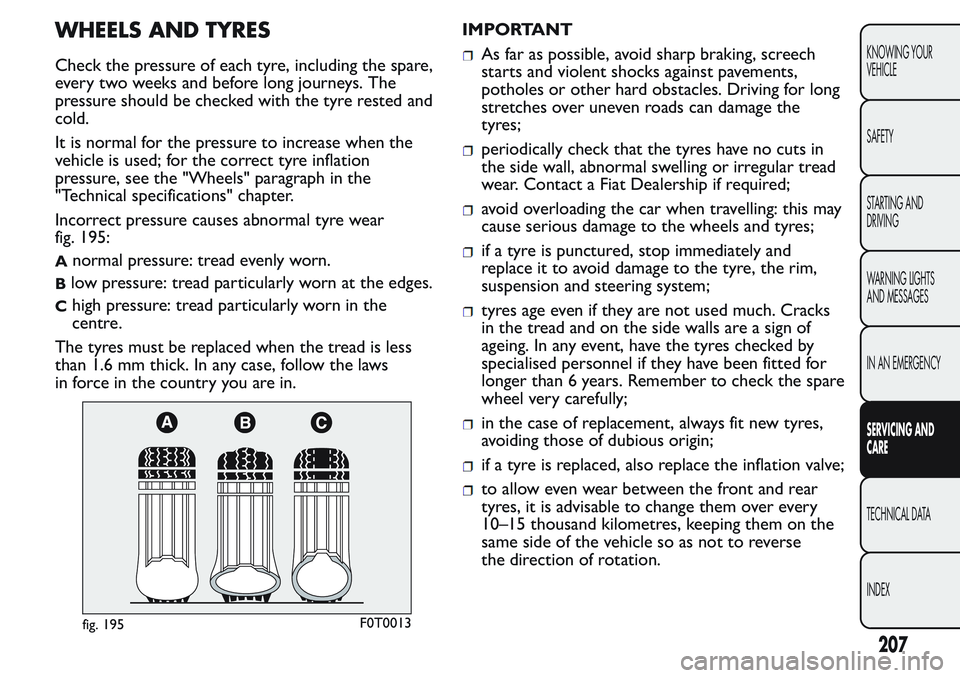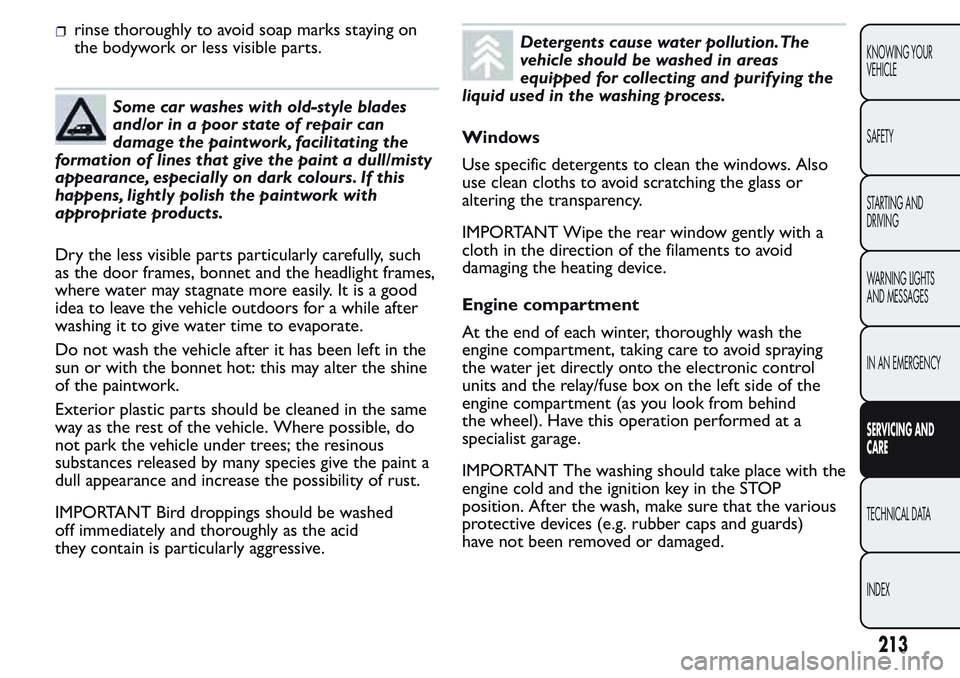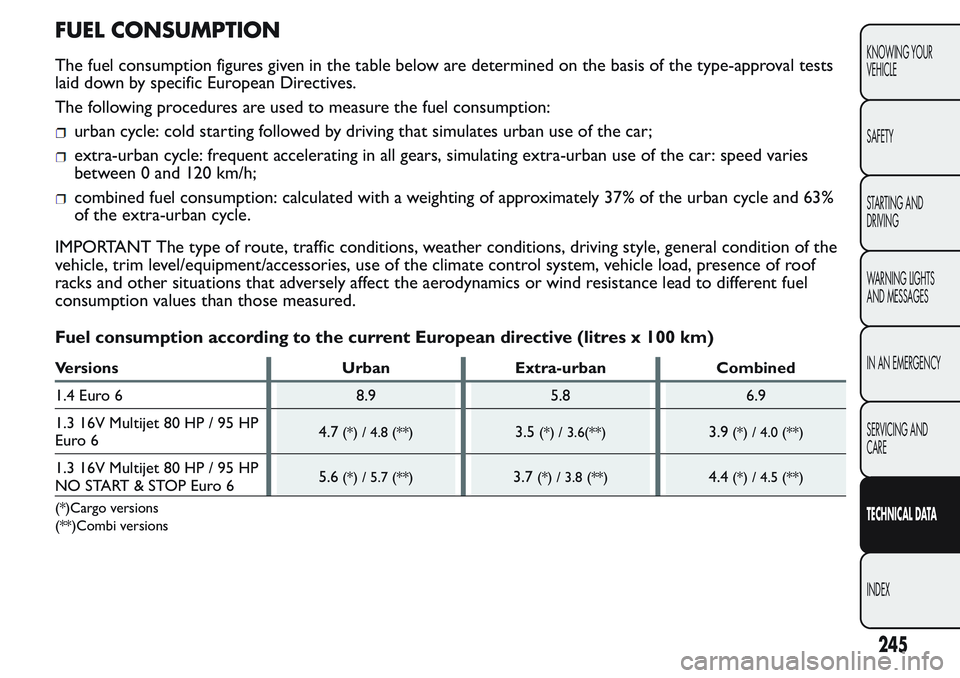stop start FIAT FIORINO 2017 Owner handbook (in English)
[x] Cancel search | Manufacturer: FIAT, Model Year: 2017, Model line: FIORINO, Model: FIAT FIORINO 2017Pages: 272, PDF Size: 5.87 MB
Page 211 of 272

WHEELS AND TYRES
Check the pressure of each tyre, including the spare,
every two weeks and before long journeys. The
pressure should be checked with the tyre rested and
cold.
It is normal for the pressure to increase when the
vehicle is used; for the correct tyre inflation
pressure, see the "Wheels" paragraph in the
"Technical specifications" chapter.
Incorrect pressure causes abnormal tyre wear
fig. 195:
Anormal pressure: tread evenly worn.
Blow pressure: tread particularly worn at the edges.
Chigh pressure: tread particularly worn in the
centre.
The tyres must be replaced when the tread is less
than 1.6 mm thick. In any case, follow the laws
in force in the country you are in.IMPORTANT
As far as possible, avoid sharp braking, screech
starts and violent shocks against pavements,
potholes or other hard obstacles. Driving for long
stretches over uneven roads can damage the
tyres;
periodically check that the tyres have no cuts in
the side wall, abnormal swelling or irregular tread
wear. Contact a Fiat Dealership if required;
avoid overloading the car when travelling: this may
cause serious damage to the wheels and tyres;
if a tyre is punctured, stop immediately and
replace it to avoid damage to the tyre, the rim,
suspension and steering system;
tyres age even if they are not used much. Cracks
in the tread and on the side walls are a sign of
ageing. In any event, have the tyres checked by
specialised personnel if they have been fitted for
longer than 6 years. Remember to check the spare
wheel very carefully;
in the case of replacement, always fit new tyres,
avoiding those of dubious origin;
if a tyre is replaced, also replace the inflation valve;
to allow even wear between the front and rear
tyres, it is advisable to change them over every
10–15 thousand kilometres, keeping them on the
same side of the vehicle so as not to reverse
the direction of rotation.
fig. 195F0T0013
207
KNOWING YOUR
VEHICLE
SAFETY
STARTING AND
DRIVING
WARNING LIGHTS
AND MESSAGES
IN AN EMERGENCY
SERVICING AND
CARE
TECHNICAL DATA
INDEX
Page 217 of 272

rinse thoroughly to avoid soap marks staying on
the bodywork or less visible parts.
Some car washes with old-style blades
and/or in a poor state of repair can
damage the paintwork, facilitating the
formation of lines that give the paint a dull/misty
appearance, especially on dark colours. If this
happens, lightly polish the paintwork with
appropriate products.
Dry the less visible parts particularly carefully, such
as the door frames, bonnet and the headlight frames,
where water may stagnate more easily. It is a good
idea to leave the vehicle outdoors for a while after
washing it to give water time to evaporate.
Do not wash the vehicle after it has been left in the
sun or with the bonnet hot: this may alter the shine
of the paintwork.
Exterior plastic parts should be cleaned in the same
way as the rest of the vehicle. Where possible, do
not park the vehicle under trees; the resinous
substances released by many species give the paint a
dull appearance and increase the possibility of rust.
IMPORTANT Bird droppings should be washed
off immediately and thoroughly as the acid
they contain is particularly aggressive.
Detergents cause water pollution.The
vehicle should be washed in areas
equipped for collecting and purifying the
liquid used in the washing process.
Windows
Use specific detergents to clean the windows. Also
use clean cloths to avoid scratching the glass or
altering the transparency.
IMPORTANT Wipe the rear window gently with a
cloth in the direction of the filaments to avoid
damaging the heating device.
Engine compartment
At the end of each winter, thoroughly wash the
engine compartment, taking care to avoid spraying
the water jet directly onto the electronic control
units and the relay/fuse box on the left side of the
engine compartment (as you look from behind
the wheel). Have this operation performed at a
specialist garage.
IMPORTANT The washing should take place with the
engine cold and the ignition key in the STOP
position. After the wash, make sure that the various
protective devices (e.g. rubber caps and guards)
have not been removed or damaged.
213
KNOWING YOUR
VEHICLE
SAFETY
STARTING AND
DRIVING
WARNING LIGHTS
AND MESSAGES
IN AN EMERGENCY
SERVICING AND
CARE
TECHNICAL DATA
INDEX
Page 249 of 272

FUEL CONSUMPTION
The fuel consumption figures given in the table below are determined on the basis of the type-approval tests
laid down by specific European Directives.
The following procedures are used to measure the fuel consumption:
urban cycle: cold starting followed by driving that simulates urban use of the car;
extra-urban cycle: frequent accelerating in all gears, simulating extra-urban use of the car: speed varies
between 0 and 120 km/h;
combined fuel consumption: calculated with a weighting of approximately 37% of the urban cycle and 63%
of the extra-urban cycle.
IMPORTANT The type of route, traffic conditions, weather conditions, driving style, general condition of the
vehicle, trim level/equipment/accessories, use of the climate control system, vehicle load, presence of roof
racks and other situations that adversely affect the aerodynamics or wind resistance lead to different fuel
consumption values than those measured.
Fuel consumption according to the current European directive (litres x 100 km)
Versions Urban Extra-urban Combined
1.4 Euro 6 8.9 5.8 6.9
1.3 16V Multijet 80 HP / 95 HP
Euro 64.7
(*) / 4.8 (**)3.5(*) / 3.6(**)3.9(*) / 4.0 (**)
1.3 16V Multijet 80 HP / 95 HP
NO START & STOP Euro 65.6(*) / 5.7 (**)3.7(*) / 3.8 (**)4.4(*) / 4.5 (**)
(*)Cargo versions
(**)Combi versions
245
KNOWING YOUR
VEHICLE
SAFETY
STARTING AND
DRIVING
WARNING LIGHTS
AND MESSAGES
IN AN EMERGENCY
SERVICING AND
CARE
TECHNICAL DATA
INDEX
Page 250 of 272

CO2 EMISSIONS
The CO2emission figures in the table below refer to combined fuel consumption.
VersionsCO2 emissions according to the current European
directive (g/km)
1.4 Euro 6161
1.3 16V Multijet 80 HP / 95 HP Euro 6 104 (*) / 106 (**)
1.3 16V Multijet 80 HP / 95 HP NO START & STOP Euro 6 115 (*) / 118 (**)
(*) Cargo versions
(**) Combi versions
246
KNOWING YOUR
VEHICLE
SAFETY
STARTING AND
DRIVING
WARNING LIGHTS
AND MESSAGES
IN AN EMERGENCY
SERVICING AND
CARE
TECHNICAL DATA
INDEX
Page 269 of 272

Rear light clusters (changing
a bulb)......................................... 172
Rear power socket ..................... 63
Rear side windows ..................... 66
Rear window washer ................. 55
Rear window wiper .................... 55
Rear-view mirrors
– Interior rear-view mirror..... 44
– Wing mirrors ......................... 44
Refuelling...................................... 240
Refuelling the vehicle ................ 102
Replacing the battery ................ 204
Replacing the rear window
wiper blade................................ 210
Replacing the windscreen
wiper blades .............................. 209
Rev counter.................................. 16
Right-hand indicator
warning light.............................. 153
Rim Protector............................. 226
Rims and tyres ............................ 224
Roof rack/ski rack ....................... 78
Roof rails....................................... 79
Rubber lines ................................ 208
Saving fuel .................................... 137
Scheduled Servicing Plan .......... 191
Seat belt reminder ..................... 147Seat belts
– Use .......................................... 107
Seats
– Accessing front seats............ 38
– Foldaway passenger seat...... 37
– Front seats .............................. 36
Setup menu .................................. 20
Side bags ...................................... 128
– Side Bags ................................ 128
Side lights - tail lights ................. 53
Side lights - tail lights
(changing a bulb) ...................... 170
Side lights/tail lights ................... 170
– Warning light ......................... 153
Side/tail lights warning light ..... 153
Sliding side doors ........................ 67
Snow chains................................. 140
Snow tyres................................... 135
Spare wheel ................................. 224
Speed block .................................. 93
Speedometer ............................... 16
Spray nozzles .............................. 210
Start&Stop system...................... 96
Starting procedure for
diesel versions .......................... 133Starting procedure for
petrol versions ......................... 132
Starting the engine .................... 132
Steering lock ................................ 15
Steering System .......................... 223
Steering wheel ............................. 43
Stopping the engine ................... 134
Storage compartment................ 62
Sun visors ..................................... 65
Suspension ................................... 223
Symbols ......................................... 8
Tail lights/rear fog light
(changing a bulb) ...................... 172
Third brake lights ....................... 174
Third brake lights (changing
a bulb)......................................... 174
Tool bag ....................................... 158
Towing the vehicle ..................... 187
Towing trailers ............................ 139
Traction Plus system .................. 91
Transmission ............................... 136
Trip Computer ............................ 33
Tyres ............................................. 224
Useful advice for extending
the life of your battery ........... 206
VIN plate...................................... 216
SAFETY
STARTING AND
DRIVING
WARNING LIGHTS
AND MESSAGES
IN AN EMERGENCY
SERVICING AND
CARE
TECHNICAL DATA
INDEX
KNOWING YOUR
VEHICLE